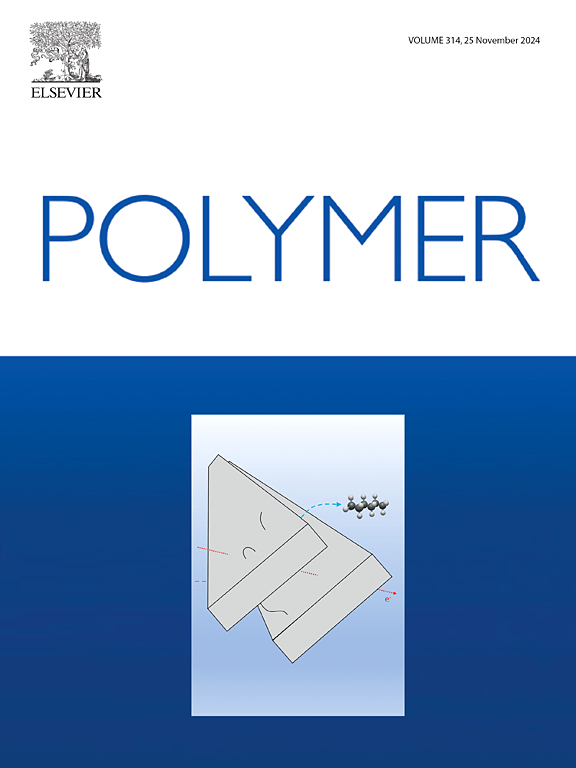Comprehensive Experimental Study of Mechanical Properties, Stress Relaxation, Shape Memory Performance, Thermal Analysis and Morphology of 3D/4D Printed HDPE-PETG
IF 4.1
2区 化学
Q2 POLYMER SCIENCE
引用次数: 0
Abstract
This study addresses the critical limitations of 3D printing with high-density polyethylene (HDPE), such as poor printability and lack of smart functionality, by developing novel HDPE-PETG blends that simultaneously enhance printing performance and introduce 4D shape memory capabilities to HDPE. Through systematic characterization of blends containing 15, 30, and 45 wt% PETG, it was demonstrated that 30% PETG content optimally balances mechanical properties, achieving 24.5 MPa tensile strength and 87.2% elongation, and printability, with a reduction in interlayer gaps compared to 15% PETG. Meanwhile, higher PETG content (45%) achieves exceptional shape memory performance with 89.0% fixity and 75.7% recovery. Dynamic mechanical analysis reveals PETG's glass transition (80°C) as the shape memory switching temperature, with SEM confirming an immiscible two-phase morphology that synergistically combines HDPE's structural integrity with PETG's thermal responsiveness. Stress relaxation also increased with increasing PETG and the HDPE with a semi-crystalline structure improves stress relaxation resistance. These results establish HDPE-PETG as a novel material system that transforms conventional HDPE into a versatile, sustainable feedstock for advanced 3D/4D printing applications, overcoming processing challenges while adding smart functionality for the first time. Also, the results indicate excellent synergy in the blends due to the use of stress relaxation resistance, recyclability, low cost due to HDPE and excellent 3D printability, shape memory effect and mechanical properties due to PETG.

3D/4D打印HDPE-PETG的力学性能、应力松弛、形状记忆性能、热分析和形貌综合实验研究
本研究通过开发新型HDPE- petg共混物,解决了高密度聚乙烯(HDPE) 3D打印的关键限制,例如打印性能差和缺乏智能功能,同时提高了打印性能并为HDPE引入了4D形状记忆功能。通过对含有15%、30%和45% PETG的共混物进行系统表征,结果表明,与15% PETG相比,30% PETG含量可以最佳地平衡机械性能,实现24.5 MPa的抗拉强度和87.2%的伸长率,以及可印刷性,同时减少了层间间隙。同时,较高的PETG含量(45%)具有优异的形状记忆性能,固相率为89.0%,回收率为75.7%。动态力学分析表明,PETG的玻璃化转变温度为形状记忆转换温度(80°C), SEM证实了HDPE的非混相两相形态,该形态将HDPE的结构完整性与PETG的热响应性协同结合。应力松弛随PETG的增加而增加,半晶结构的HDPE提高了抗应力松弛性。这些结果确立了HDPE- petg作为一种新型材料系统,将传统HDPE转变为先进3D/4D打印应用的多功能可持续原料,克服了加工挑战,同时首次增加了智能功能。此外,由于HDPE具有抗应力松弛性、可回收性、低成本,以及PETG具有优异的3D打印性、形状记忆效应和机械性能,因此在共混物中具有良好的协同作用。
本文章由计算机程序翻译,如有差异,请以英文原文为准。
求助全文
约1分钟内获得全文
求助全文
来源期刊

Polymer
化学-高分子科学
CiteScore
7.90
自引率
8.70%
发文量
959
审稿时长
32 days
期刊介绍:
Polymer is an interdisciplinary journal dedicated to publishing innovative and significant advances in Polymer Physics, Chemistry and Technology. We welcome submissions on polymer hybrids, nanocomposites, characterisation and self-assembly. Polymer also publishes work on the technological application of polymers in energy and optoelectronics.
The main scope is covered but not limited to the following core areas:
Polymer Materials
Nanocomposites and hybrid nanomaterials
Polymer blends, films, fibres, networks and porous materials
Physical Characterization
Characterisation, modelling and simulation* of molecular and materials properties in bulk, solution, and thin films
Polymer Engineering
Advanced multiscale processing methods
Polymer Synthesis, Modification and Self-assembly
Including designer polymer architectures, mechanisms and kinetics, and supramolecular polymerization
Technological Applications
Polymers for energy generation and storage
Polymer membranes for separation technology
Polymers for opto- and microelectronics.
 求助内容:
求助内容: 应助结果提醒方式:
应助结果提醒方式:


